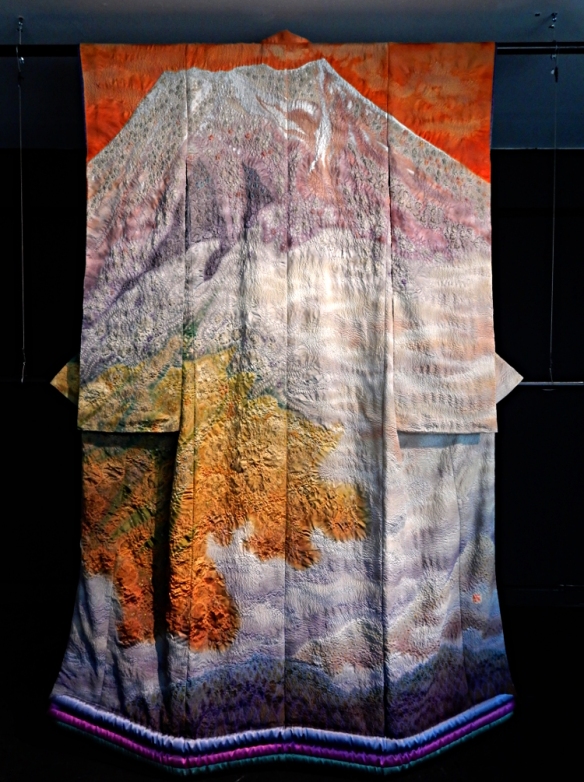We included the small city of Kanazawa as a destination on our Japan trip for just one reason, the “Kaga Yuzen” textile dyeing tradition for which the area is famed. We also knew that it had one of Japan’s most famous gardens.
What we found was a delightful city that was full of treasures to explore and had most of its tourist sights within one compact area. From the moment we arrived at Kanazawa’s futuristic train station until we left it provided a succession of “better than expected” experiences and I could happily recommend it to any traveller.

Most visitors first encounter Kanazawa through its futuristic train station

The great sculptural arch outside Kanazawa station

Kimono on display at a Kaga Yuzen artist’s studio
Getting around Kanazawa is very easy, with many of the sights being within walking distance of each other. All the main visitor spots can also be easily reached by the “Kanazawa Loop Bus” that can be used with a convenient day pass.

The quirky tourist loop buses provide easy access to all the sites
The city has for centuries been the centre of one of Japan’s richest and most productive agricultural regions. This, plus the fact that it was not bombed during the second world war means that it is rich with historic architecture and artefacts. There are still largely intact samurai and geisha districts to wander around with many houses open for visitors. The city also boasts many museums devoted to various aspects of its cultural heritage, far more than we could take in on a short visit. Modern culture is also very noticeable with interesting sculpture dotted all around and a spectacular new Museum of Twenty-First Century Art.

A street in the historic Geisha district of Kanazawa

The famous Kutani ware ceramics are just one of many local craft products

The exciting Museum of Twenty-First Century Art
The jewel in Kanazawa’s crown is the beautiful “Kenrokuen”, a large stroll garden developed over centuries by the Maeda lords of Kanazawa. For lovers of Japanese gardens this is a must see, for others it is a very nice addition to the itinerary if you are here anyway, though I think Kyoto is still the place to learn all about the richness and variety in this nations garden art.

Just one of many scenic views in the Kenrokuen
The best and biggest surprise in Kanazawa is just across an old castle moat from Kenrokuen. (The moat is now a main city highway.) Here is the great restoration project of Kanazawa castle. The main castle buildings were destroyed by fire in the nineteenth century but parts are gradually being rebuilt through a remarkably impressive combination of archaeology, craft skills and education project.
The results are both stunning and informative. The ability to compare an original gatehouse with a newly rebuilt one using the exact same techniques is surprisingly rewarding, helped for us by a very enthusiastic guide who expounded at length on traditional Japanese woodworking techniques.

Kanazawa Castle is slowly being rebuilt

A newly rebuilt castle gatehouse

A large and bustling food market is another favourite Kanazawa destination

Kanazawa was full of surprises. We found excellent Sri Lankan food down a little side street
I plan further posts on Kanazawa’s delights including my next one on Kaga Yuzen dyeing. I hope that this introduction has made it clear that Kanazawa is a great place to visit!
See also:
Japan 1 – Nishijin Textile Centre
Japan 2 – Matsumoto Castle






























 Unfortunately, there was no way to get a better view (though I did consider sending Alex up a tree), but hopefully these photos will convey some of the drama.
Unfortunately, there was no way to get a better view (though I did consider sending Alex up a tree), but hopefully these photos will convey some of the drama.





















































































































